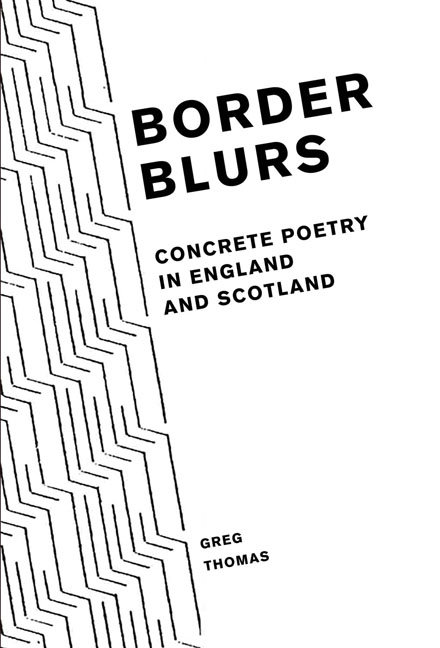Book contents
- Frontmatter
- Contents
- Dedication
- Figures
- Notes on Referencing
- Acknowledgements
- 1 Introduction
- 2 Concrete Poetry/Konkrete Poesie/Poesia Concreta: The International Scene
- 3 Order and Doubt: Ian Hamilton Finlay
- 4 Off-Concrete: Edwin Morgan
- 5 Apophasis: Dom Sylvester Houédard
- 6 Abstract Concrete: Bob Cobbing
- 7 ?Concrete Poetry and After: Conclusion
- Works Cited
- Index
2 - Concrete Poetry/Konkrete Poesie/Poesia Concreta: The International Scene
- Frontmatter
- Contents
- Dedication
- Figures
- Notes on Referencing
- Acknowledgements
- 1 Introduction
- 2 Concrete Poetry/Konkrete Poesie/Poesia Concreta: The International Scene
- 3 Order and Doubt: Ian Hamilton Finlay
- 4 Off-Concrete: Edwin Morgan
- 5 Apophasis: Dom Sylvester Houédard
- 6 Abstract Concrete: Bob Cobbing
- 7 ?Concrete Poetry and After: Conclusion
- Works Cited
- Index
Summary
On May 25, 1962 a letter from the Portuguese poet E.M. de Melo e Castro appeared in the Times Literary Supplement (TLS) in response to an article by deputy editor John Willett entitled ‘Poetry, Prose and the Machine’ (May 4, 1962):
Sir,—I have read with great interest the article ‘Poetry, Prose and the Machine’ by a Special Correspondent in your issue of May 4, but I cannot help feeling surprised at his not mentioning the increasingly important movement of poesia concreta, which originated in Brazil and is now reaching Portugal. In fact poesia concreta is a successful experiment in ideogrammatic or diagrammatic writing and poetic creation precisely on the lines to which your Correspondent refers.
This kind of experiment is slowly replacing the traditional descriptive method of communication by a visual, compact, ideogrammatic way of bringing about and conveying complex and subtle relations among ideas, images, words, things, &c. Poesia concreta is arousing a wave of interest both in Brazil and in Portugal, especially among young people and the most advanced poets. (Melo e Castro 1962b)
In his 1964 article ‘Paradada’, published in the first of two subsequent editions of the TLS dedicated to the ‘Changing Guard’ in contemporary poetry, the concrete poet and Benedictine monk Dom Sylvester Houédard emphasised the importance of this seemingly incidental little note: ‘edwin morgan / ian h finlay / anselm hollo / myself all came to concrete directions out of different places thru TLS letter 250562’ (Houédard 1964d). As Houédard suggests in his distinctively clipped, beat-style prose, the practice of concrete poetry in England and Scotland stems largely from several independent encounters with Melo e Castro's letter. The Glaswegian poet Edwin Morgan, upon reading it, wrote directly to Melo e Castro, who promptly sent him an anthology of Brazilian concrete poetry published by the Brazilian Embassy in Lisbon, along with the address, in Sao Paulo, of the concrete poet and founding member of the Noigandres group Augusto de Campos. Morgan also reported his findings to his friend the Edinburgh-based poet Ian Hamilton Finlay, who printed concrete poetry for the first time in the British Isles early in 1963, in the sixth issue of his literary journal Poor.Old.Tired.Horse.
- Type
- Chapter
- Information
- Border BlursConcrete Poetry in England and Scotland, pp. 19 - 64Publisher: Liverpool University PressPrint publication year: 2019



